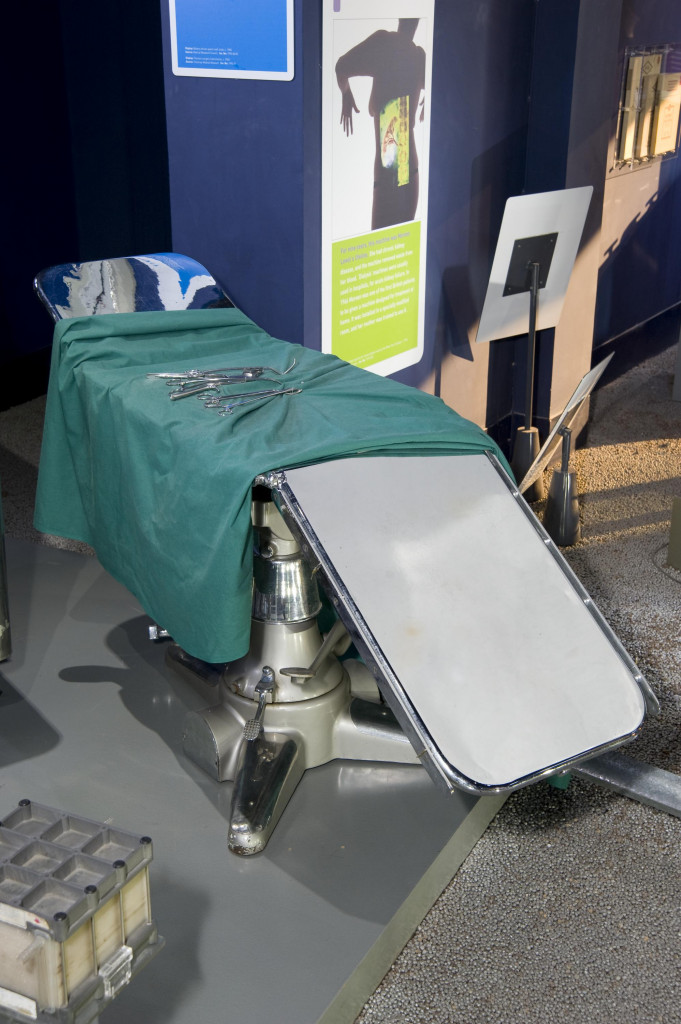In the first episode of The Crown, a new Netflix drama series looking at the life of HM Queen Elizabeth II, showed the George VI’s lung operation carried out by surgeon Sir Clement Price Thomas (1893-1973) on a Sunday morning, 23 September 1951. The news made headlines all over the world.
For The Crown, a group of practicing surgeons and theatre staff from Guys and St Thomas’ Trust came together to re-enact the operation in what is thought to be a television first.
For the operation in 1951, an operating theatre was set up within the private confines of Buckingham Palace, complete with staff from Westminster Hospital.
The operating table used in the operation, made by the Genito-Urinary Manufacturing Company Limited, was gifted to the Science Museum in 1984 from Westminster and Roehampton Hospital and has a small plaque commemorating the operation:
“To record with gratitude the recovery of His Majesty King George VI from an operation performed by C. Price Thomas F.R.C.S., Anaesthetist Dr. Robert Machray, Assisted by Theatre Sisters Miss S. Minter and Miss V. Ream and Staff Nurses Miss A. Patterson and Miss H. Ross when this table together with all the necessary theatre equipment was lent by Westminster Hospital, 23rd September 1951”

This plaque got me interested on the lives of the staff after the operation. Long-time readers of this blog will remember Katie Dabin’s blog post which featured an interview with Sarah Minter, Senior Theatre Sister, who was present at the operation.
Clement Price Thomas is considered one of the pioneers of thoracic surgery. Legend has it that Price Thomas only agreed to operate on the King if he could treat the monarch like any other patient. Charles Drew (1916-87) and Peter Jones (1917-84) assisted Price Thomas, closing up the King at the completion of the operation, following the patterns that echoed their normal operating practice. The surgeon in charge is said to have said “I haven’t stitched up a chest for 25 years and I’m not going to start practising today!”
Jones (1917-1984) spent three weeks living in Buckingham Palace, monitoring the King’s progress and went onto to follow his mentor in thoracic surgery. Drew went on to pioneer profound hypothermia for open heart surgery and we also have his equipment in the collections. In a profound twist of fate, Drew would perform the same operation on Price Thomas as Price Thomas performed on George VI.
Cyrill Scurr, junior anaesthetist was also present at the King’s operation and has recounted his experiences on the Anaesthesia Heritage Centre blog and also donated the ECG machine that was used to the Association of Anaesthetists of Great Britain and Ireland.
Four nurses, Audrey Patterson, Hilda Ross, Vera Ream and Sarah Minter, assisted in the operation. A further four nurses did shifts during the King’s convalescence. Sister Janet Cleminsen and Ruth Beswetherwick took the night shifts and Sister Doreen Pearce and Sister Kathleen Norman took the day shifts. They all found themselves named and pictured in the Illustrated London News in October 1951.
The George VI operating table is not the only royal item in the collection. We also have the operating table that was used to remove an abscess on Edward VII’s appendix in 1902, two days before the monarch’s coronation. The operation was carried out Frederick Treves (1853-1923).
From royal births to hospital visits, our fascination with the medical treatment of royalty continues today.